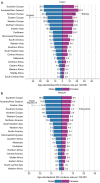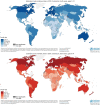Implications of the growing incidence of global colorectal cancer
- PMID: 34422402
- PMCID: PMC8343084
- DOI: 10.21037/jgo-2019-gi-06
Implications of the growing incidence of global colorectal cancer
Abstract
The expanding worldwide burden of colorectal cancer (CRC) is a significant public health issue. Understanding the shift in the geo-demographic, socioeconomic, environmental, and biogenetic distribution of CRC is paramount. The Human Development Index (HDI) measuring life expectancy, education, and gross national income is a composite index comparing health outcomes between countries. This has been shown to be a useful comparison tool in measuring the health dimension among high, middle, and low-income countries. CRC has a wide global distribution in incidence and mortality with majority of cases occurring in countries with a high or very high HDI. However, in developing countries and in those undergoing rapid socioeconomic growth, there has also been a marked rise in CRC rates as well. This pattern is noted globally and seems to correlate with increase in a country's specific HDI. Additionally, another unique pattern of CRC incidence has emerged with more cancers being diagnosed in adults younger than 50 years old. Further investigation is needed to determine CRC risks reduction and implementation of primary prevention and early detection strategies within different country specific healthcare systems. Globally, improvement in healthcare equality, access to medical care and screening for CRC particularly in resource-limited (low HDI) countries is essential.
Keywords: Colorectal cancer (CRC); Human Development Index (HDI); global.
2021 Journal of Gastrointestinal Oncology. All rights reserved.
Conflict of interest statement
Conflicts of Interest: All authors have completed the ICMJE uniform disclosure form (available at http://dx.doi.org/10.21037/jgo-2019-gi-06). The series “Global GI Malignancies” was commissioned by the editorial office without any funding or sponsorship. John F Gibbs served as the unpaid Guest Editor of the series and serves as an unpaid editorial board member of Journal of Gastrointestinal Oncology from Jan 2019 to Dec 2020. The authors have no other conflicts of interest to declare.
Figures







References
-
- American Cancer Society. Colorectal Cancer Facts & Figures 2020-2022. Atlanta: American Cancer Society, 2020.
-
- Ferlay J, Soerjomataram I, Ervik M, et al. GLOBOCAN 2012 v1.0, Cancer Incidence and Mortality Worldwide: IARC Cancer Base No. 11. Lyon, France: International Agency for Research on Cancer, 2013.
-
- United Nations Development Programme. Human Development Report 2019: Beyond Income, Beyond Averages, Beyond Today - Inequalities in Human Development in the 21st Century. New York: UN, 2019.
Publication types
LinkOut - more resources
Full Text Sources
